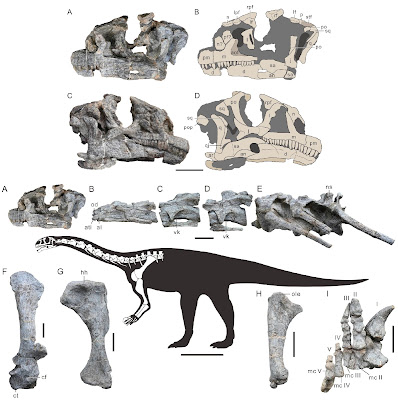 |
| Wudingloong wui Y.-M. Wang, Zhang, Y.-C. Wang, H. Xu, Chen, Feng, X. Xu, T. Wang & You, 2025 |
Abstract
A new dinosaur assemblage from the Lower Jurassic at Wande Town, Wuding County, Yunnan Province, China is discovered recently. Here a new sauropodomorph from this site, Wudingloong wui gen. et sp. nov., is described on the basis of a partial skeleton. Wudingloong is different from other non-sauropodiform sauropodomorphs particularly in having an ascending ramus of the maxilla excavated by triangular antorbital fossa, distinct ventral keel on the middle cervical centra, a slender humerus with a flat and low humeral head, a gracile metacarpal V with the proximal end as wide as the distal end, and a large and robust ungual of manual digit I. Wudingloong was excavated from the lowest Lower Jurassic Yubacun Formation, which is the lowest dinosaur bone bed in East Asia. Both the phylogenetic analysis and stratigraphic horizon indicate that Wudingloong represents the earliest-diverging and stratigraphically oldest sauropodomorph dinosaur discovered in East Asia so far. The discovery of this new taxon provides further evidence that the southwestern China sauropodomorph assemblage is one of the most taxonomically diverse and morphologically disparate in the pre-Toarcian Early Jurassic worldwide, represented by various taxa from near the base of the Massopoda to non-sauropodan sauropodiforms.
Systematic palaeontology
Dinosauria Owen, 1842.
Saurischia Seeley, 1887.
Sauropodomorpha Huene, 1932.
Massopoda Yates, 2007.
Wudingloong wui gen. et sp. nov.
Etymology: The genus name, Wudingloong, “Wuding” refers to Wuding County where the fossil site was found, and “loong” means Chinese “龙”. The specific name, wui, honors Dr. Xiao-Chun Wu (Canadian Museum of Nature) for his significant contribution to the research on the dinosaurs and other vertebrate fossils from Yunnan Province.
Diagnosis: A small to medium-sized non-sauropodan sauropodomorph (Tables S1–S4) diagnosed by the following unique combination of characters (autapomorphies indicated by an asterisk): ascending ramus of the maxilla excavated by triangular antorbital fossa; axial intercentrum wider and completely fused to the axis; distinct ventral keel on middle cervical centra; slender shaft of the humerus with a flat and low humeral head; a large and robust ungual of manual digit I with length, proximal height and width three times those of the ungual of manual digit III *; gracile metacarpal V with proximal end as wide as distal end*.
Locality and horizon: The specimen was excavated from the Lower Jurassic Yubacun Formation (Hettangian to early Sinemurian, probably 200.17 Ma14) at Wande Town, Wuding County, Yunnan Province, China. ...
Ya-Ming Wang, Qian-Nan Zhang, Yan-Chao Wang, Huan Xu, Jianbo Chen, Zhuo Feng, Xing Xu, Tao Wang and Hai-Lu You. 2025. A New Early Jurassic Dinosaur represents the Earliest-diverging and Oldest Sauropodomorph of East Asia. Scientific Reports. 15: 26749. DOI: doi.org/10.1038/s41598-025-12185-2 [23 July 2025]


